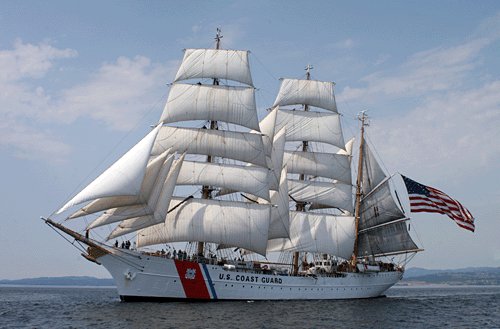USCG Cutter Eagle


USCG Cutter Barque Eagle Sailing
USCGC Eagle is the sixth U.S. Coast Guard cutter to bear the name in a proud line dating back to 1792. The ship was built in 1936 by the Blohm and Voss Shipyard in Hamburg, Germany, and commissioned as Horst Wessel. (Five identical sister ships were also built.)
Originally operated by Nazi Germany to train cadets for the German Navy, the ship was taken by the United States as a war prize after World War II. In 1946, a U.S. Coast Guard crew - aided by the German crew still on board - sailed the tall ship from Bremerhaven to its new homeport in New London, Connecticut. Eagle returned to Bremerhaven for the first time since World War II in the summer of 2005, to an enthusiastic welcome.
Built during the twilight era of sail, the design and construction of Eagle embody centuries of development in the shipbuilder's art. The hull is steel four-tenths of an inch thick. There are two full-length steel decks with a platform deck below. The raised forecastle and quarterdeck are made of three-inch thick teak over steel, as are the weather decks.
Eagle eagerly takes to the elements for which she was designed. Effortlessly and gracefully, she drives under full sail in the open ocean at speeds up to 17 knots. When in homeport in New London, Eagle rests alongside a pier on the Thames River near the U.S. Coast Guard Academy. The Academy was originally founded in 1876 when nine students boarded the Revenue Cutter Dobbin. A series of cutters followed the Dobbin and, in 1932, a permanent shore facility was established at its present site on land donated by the New London community. Approximately 1,000 men and women attend the Academy, all of whom sail at one time or another on America's only active duty square rigger.
Eagle offers future officers the opportunity to put into practice the navigation, engineering, and other professional theory they have previously learned in the classroom. Upper class trainees exercise leadership and service duties normally handled by junior officers, while underclass trainees fill crew positions of a junior enlisted person, such as helm watches at the huge wooden wheels used to steer the vessel. Everyone who trains on Eagle experiences a character building experience.
To maneuver Eagle under sail, the crew must handle more than 22,000 square feet of sail and five miles of rigging. Over 200 lines control the sails and yards, and every crew-member, cadet and officer candidate, must become intimately familiar with the name, operation, and function of each line.
A permanent crew of six officers and 55 enlisted personnel maintain the ship year round. They provide a strong base of knowledge and seamanship for the training of up to 150 cadets or officer candidates at a time.
On the decks and in the rigging of Eagle, young men and women get a taste of salt air and life at sea and they are tested and challenged, often to the limits of endurance. Working aloft, they meet fear and learn to overcome it. The experience builds character and helps future officers develop skills of leadership and teamwork that prove valuable assets throughout their careers.
USCG Cutter Barque Eagle Schedule
If you would like to tour the USCG Cutter Barque Eagle (if and when availible) click here